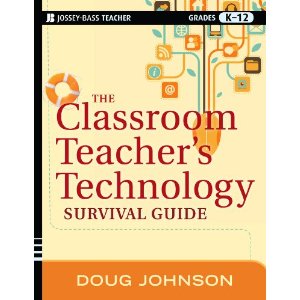BYOD to the library
BYOD to the library
Doug Johnson
Head for the Edge, LMC August/September 2012
When I leave my smart phone at home, it feels like I’m operating with only half my brain all day. And heaven knows, I have little brain power to spare. My ubiquitous access to e-mail, contacts, and calendar are gone when my phone plays hooky. But so is my ability check the weather, read an e-book, and find information online.
I am not alone. These small, powerful, increasingly affordable devices are the outboard brains for a growing number of people, including our students. In just a few years, we will look back and wonder how people ever got along without continuous connectivity to the Internet.
Schools that recognize the necessity of this connectivity for students are looking for creative means of supplying it. BYOD (Bring Your Own Device) is a popular buzzword in technology circles. BYOD programs don’t just allow, but encourage, students to bring and use their personally-owned computing gizmos in school. This approach is appealing to schools that choose not to support 1:1 computer to student programs but still want to increase kids’ ready access to digital resources.
As the prices of tablets, netbooks, laptops, e-book readers, and smart phones fall, an ever greater number of families can afford these machines. Adding such devices to a school supply list becomes feasible when they don’t cost much more than a graphing calculator.
My district has a BYOD project we call ELF-Tech (Extending Learning Forever with Technology). Its goals include:
- increasing motivation and engagement in the classroom
- supporting differentiated instruction efforts
- increasing student access to school provided e-books, e-textbooks, and Moodle units
- supporting online collaborative work in the classroom
- developing workable rules and skills for classroom teachers in managing student-owned technologies
We’ve let parents know what capabilities they should be looking for as they purchase personal technologies for their children: wi-fi, a long battery life, and a web browser that allows access to GoogleApps for Education, our student information system student portal, Moodle, the state’s content databases, and our district’s library catalog, and other online resources.
So what does this have to do with libraries? Indispensable librarians and vital library programs are integral to the technology efforts in schools - or should be. This is true once again as schools and teachers expend efforts to make student-owned computing devices productive learning tools.
Here are some things all librarians should be asking themselves if their schools are figuring out ways of giving all students continuous access to online resources, whether through student or school owned devices:
-
Do my library rules help students take advantage of their mobile computing devices? If your library bans student-owned devices and does not have wireless access for students, think again. As students use these tools to access information, educational resources, and e-text books, your library will need to be not just the place where they can connect, but where connectivity is the best! Oh, is the library the best place in the school to charge your batteries?
-
Can students and staff get knowledgeable support in my library when they have problems or questions? If students are having problems connecting to the network, logging in to an online program, or finding or using a digital resource, the library needs to be the first place students (and teachers) consider when going for help. Student library volunteers can compliment the professional staff in doing this work.
-
Am I selecting library resources with mobile computing devices in mind? Consider how your digital library resources work on a spectrum of devices, some with smaller screens. E-books should be chosen in formats that can be read on as many different e-readers, tablets, and smart phones as possible, not just a single platform. (Circulating e-readers is an expensive, unsupportable plan that will fast be eclipsed by students’ wanting e-books that can be read on their personal devices.)
-
In my role as instructional leader, am I using best practices that take advantage of a ubiquitous technology environment - and helping my teachers do so as well? When teaching information literacy skills, you should be having students use their own technologies to engage with the material. Online programs like Socrative allow students to respond to questions using a variety of devices instead of dedicated student response systems. Your guides, templates, and other instructional materials should be in GoogleDocs or a similar online program.
-
Do I exemplify a learner who takes advantage of having continuous access to the Internet? Take your own device to meetings and use it for note taking and finding information. Replace those paper agendas and other documents with electronic versions. Call on your peeps for help using Twitter. When you run meetings, encourage those attending to use their own devices.
If your school is going 1:1 or BYOD, you as a librarian need to be supporting the effort. If we as a profession don’t figure out how to be a vital part of these initiatives, we may not be BYOD but DOA.




